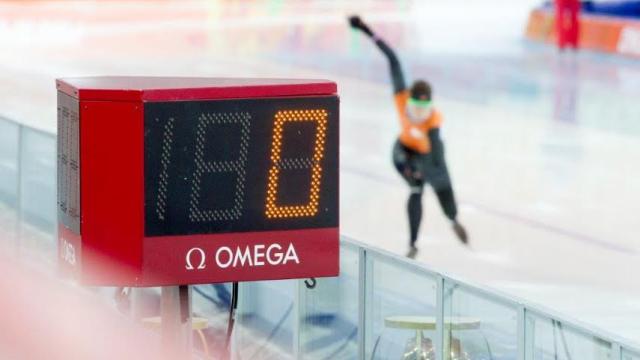Three one-thousandths of a second is less than 1/10th of a blink, less than 1/100th of a heartbeat. But if you’re a speedskater, 0.003 seconds can be the difference between gold and silver. So how are Olympics timekeepers able to get such ridiculous precision and accuracy? For the inside scoop, we talked to Omega’s Peter Hürzeler, head of Olympic timekeeping.
You can probably guess that modern timekeeping is a far cry from jacketed men with stopwatches, but the gigantic athletic information service that Omega has become is still mind-boggling. In fact, it doesn’t limit itself to just split-seconds; it maintains a database of every single athlete, their names, nationalities, and rankings for even for non-timed sports like figure skating and curling.
In between Olympics, Omega isn’t sitting idle, either. They’re responsible for the record-keeping of pretty much every major international sports competition, from swimming to cycling to the biathlon. “To only do Olympic Games, it is not possible,” Hürzeler told me. “You have to practice during all the years.” So how do they do it?
Before the Olympics
Two years before the opening ceremony, Omega begins supervising the installation of timekeeping equipment. (There’s already a two-person team Rio.) The equipment, including scoreboards, photo-finish cameras, and photocells, is sold instead of rented to the construction contractors, as they’ll still be used at the stadiums after the Games. Sochi alone is hosting 230t of timekeeping equipment, and nearly 80.5km of optical fibre.
Equipment checks begin as early as a year prior to the opening ceremonies. Two weeks before competition starts, a staff of 260 timekeeping professionals descends to prepare for the games.
There are inevitably delays in the construction, says Hürzeler. But the race sites at Sochi, at least, have all been fine. Of the 17 Olympics he’s worked at, he cites Athens as the most egregious offender. “They finished the swimming pool during the first event. Put the paint on the walls,” he recalls.
The Starting Line
RIP starting pistol; hello “electronic start system”. Since the Vancouver games four years ago, the traditional powder pistol has been replaced with markedly less badass flash pistol. But it’s also a lot more technologically sophisticated. The electronic start system simultaneously does three things: creates a flash, sets off a bang, and starts the clock. Loudspeakers transmit the sound to all of the athletes simultaneously.
Depending on the sport, racetracks are also installed with laser photocells — essentially tripwires made of light — and/or athletes are fitted with small transponders that report on false starts, lap times, and finish times.
All this data from the race in progress is monitored by a few staff in a timing control booth. The timekeepers have their eyes glued to the screen to make sure all equipment is all working and every athlete timed. But all they see are numbers, no names, to help prevent any bias from leaking in.
[clear] [clear]
The Finish Line: Is There Really Such a Thing as a Tie?
If you really think about it, there’s no such thing as a tie. There is always an infinitesimally small difference between any two finishers, as long as you have instruments powerful enough to discern it. But while Omega has had the technology to measure down to a thousandths of a second since the 1948 London games, you only ever see times displayed to the hundredths. What gives?
The rules for ranking athletes are made by the federations of individual sports. In alpine skiing, which had the first tie for Olympic gold ever at Sochi, times are only released to the hundredths even though Omega’s instruments measures it out to the thousandths. In speedskating, however, times are displayed to hundredths but ties are broken by looking at the thousandths, which is why the Netherland’s Koen Verweij had to settle for second by 0.003 seconds in the men’s 1500. In alpine, he would have shared the gold.
Because alpine skiers race one at a time — against the clock rather than against each other — we can only compare finishing times from photocells. When athletes are simultaneously racing however, Omega uses a photo-finish camera that captures a whooping 2000 frames per second. The photo-finish gives the official times, when it is available.
Today’s high-speed motion photography has made huge strides from its origins as the whim of a rich man obsessed with horses. In the late 1800s Leland Stanford — yes, that Stanford — hired photographer Eadweard Muybridge to settle the question of whether horses galloped with all four feet off the ground. The techniques Muybridge came up for high-speed motion photography set in motion a chain of inventions that culminate in the photofinish camera of today; Rebecca Solnit’s excellent book River of Shadows delves deeper into the foundation of today’s photo finishes.
While those famous images were captured in the late 19th century, it took until the 1948 London games for early versions of both the photocell and the photo-finish technology to make their way into the Olympics. At the time, film from the photo-finish camera still had to be developed, so 20 or 30 minute wait wasn’t uncommon. Today, it’s completely instantaneous.
So tonight, as you watch the tape-delayed finishes of speedskating, biathlon, bobsled and more, take a few thousandths of a second to consider the technology that lets us know exactly how fast these athletes are going — and who’s winning by how many blinks of an eye.
Images courtesy of Omega
